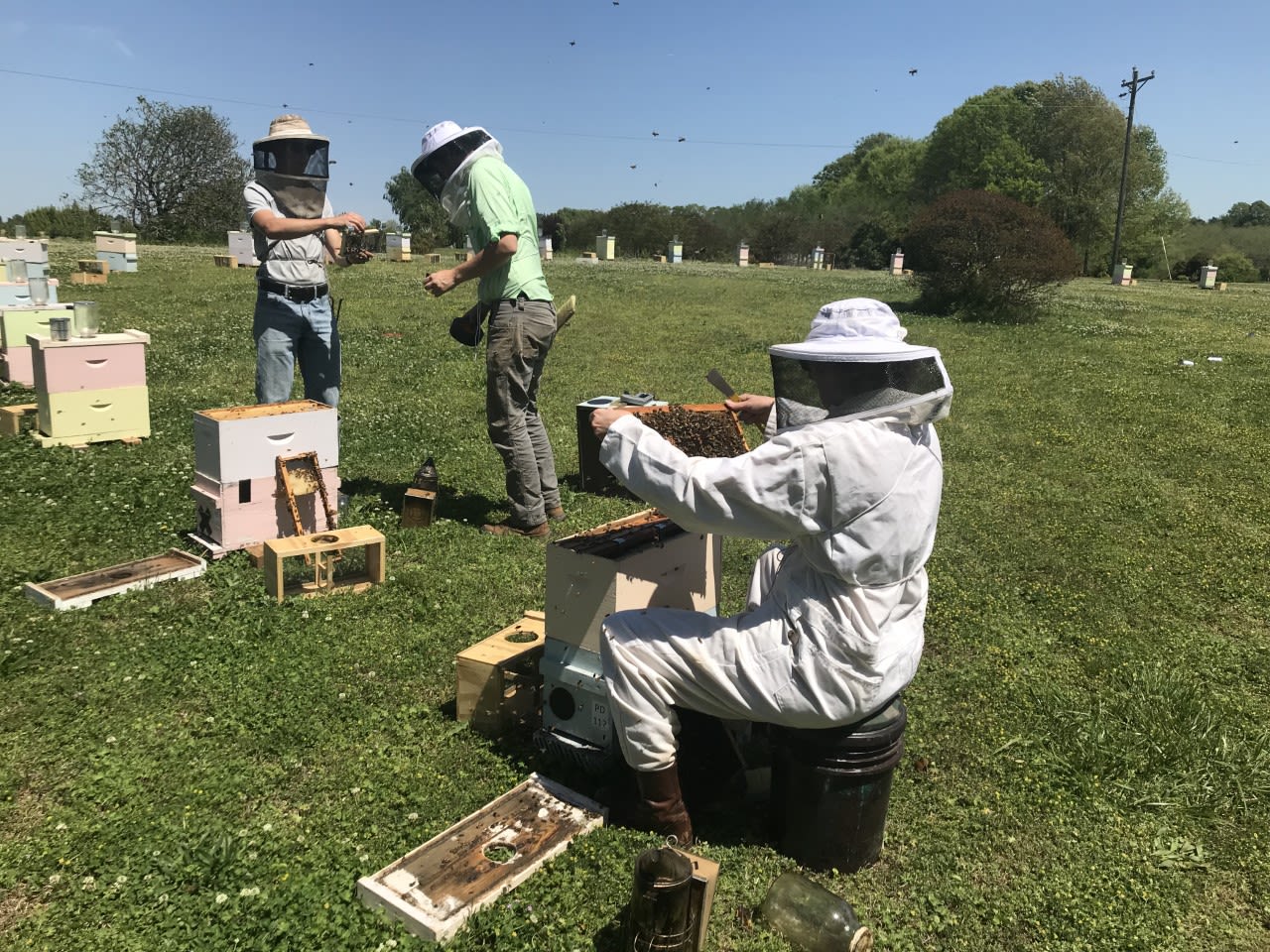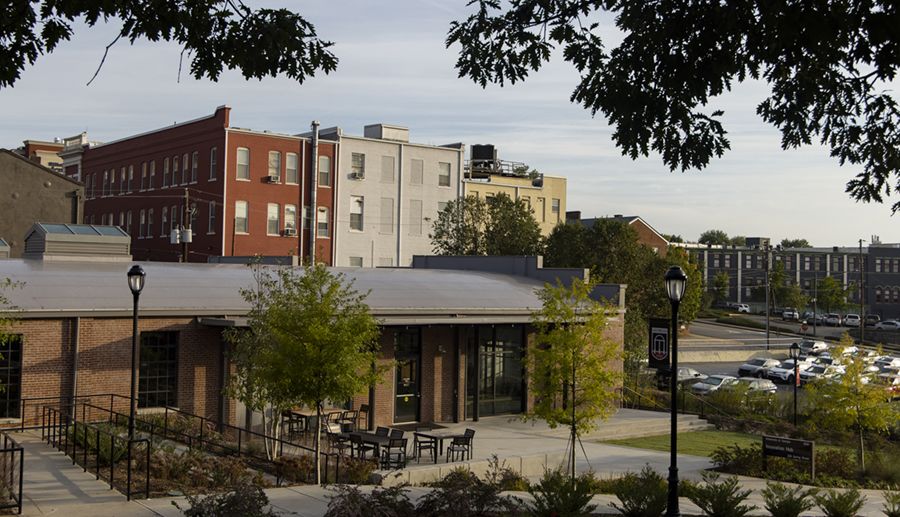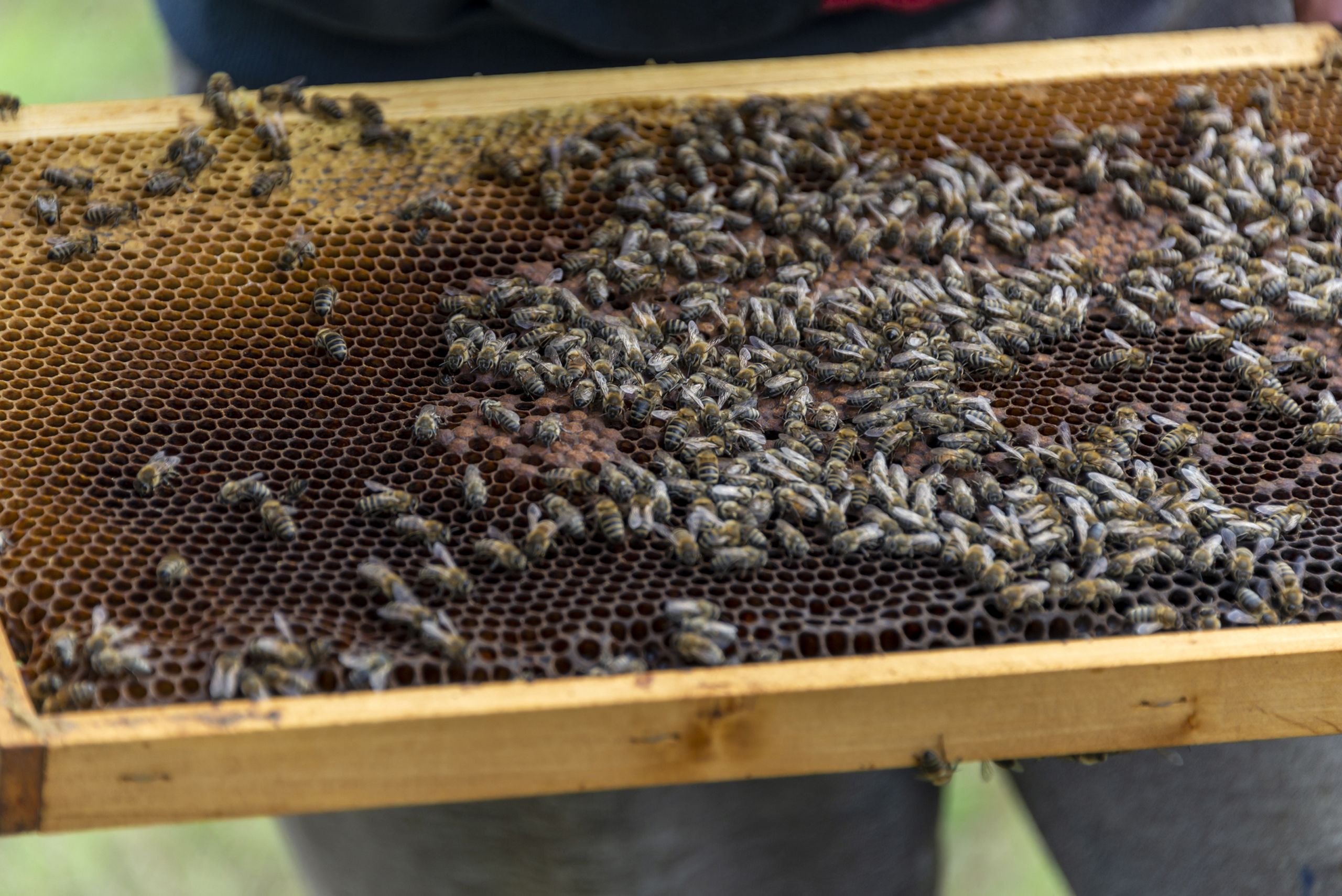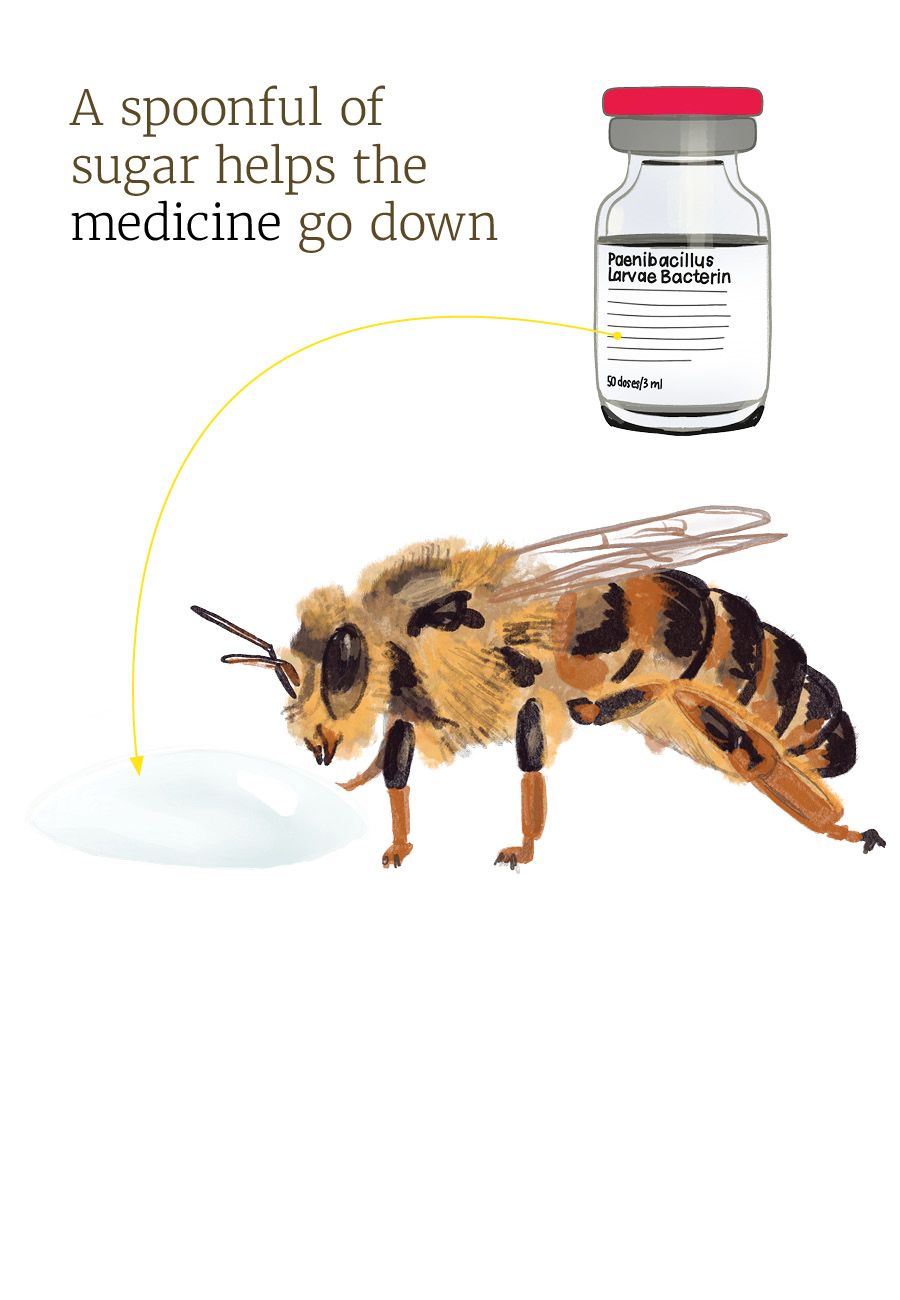Fighting foulbrood:
Advancing the world’s first honey bee vaccine
CAES partners with Dalan Animal Health to create the first insect vaccine to aid declining honey bee populations


Researchers from the UGA Bee Lab study hives. Delaplane says that honey bee vaccines are a game-changer for beekeepers who have had few resources beyond supportive therapies for decades. (Photo by Keith Delaplane)
Researchers from the UGA Bee Lab study hives. Delaplane says that honey bee vaccines are a game-changer for beekeepers who have had few resources beyond supportive therapies for decades. (Photo by Keith Delaplane)
Vaccines are a proven benefit in the world of animal science. People have vaccinated both pets and livestock for decades.
Now beekeepers will be able to protect their colonies through vaccination. The University of Georgia College of Agricultural and Environmental Sciences (CAES) and Dalan Animal Health have teamed up to advance the world’s first honey bee vaccine. The vaccine received a conditional license from the USDA Center for Veterinary Biologics in early January.
“You don’t have to look far to know honey bees are having a lot of problems right now. Hives will die unless you intercede with herculean efforts,” said Keith Delaplane, professor in the CAES Department of Entomology and director of the UGA Bee Program.

Keith Delaplane
Keith Delaplane
He wasn’t sure what would come of an initial meeting with Dalan set up by the Athens-Clarke County Economic Development Department, but Delaplane is proud that the company came to Athens and to UGA.
“The timing is right for it to be coming to our college,” Delaplane said.
Annette Kleiser, co-founder and CEO of Dalan, built the company in a virtual format to optimize the creativity of a team of experts based around the world. While the virtual model works for their team, Kleiser acknowledged the need for a “home base” for the company — a space for labs, offices and growth.
“We looked around at all the things we would like to have for an insect health company,” Kleiser said. “We wanted a world-class university with access to talent, with a veterinary school that understood animal vaccines, that is focused on agriculture and sustainable agriculture and that has a bee lab.”
The company also needed a location with a climate where research could be active nine-plus months of the year and, ideally, a culture of entrepreneurship, Kleiser added. The proximity to Atlanta to serve a global product with a global program was an added benefit.
“We made this wish list and there was Athens, Georgia,” Kleiser said. “We visited and met with the economic development folks and they introduced us to many people, including Keith. We saw the enthusiasm for what we were doing — there was an alignment.”

The Delta Innovation Hub is part of UGA's Innovation District, located on North Campus close to downtown Athens. (Photo by Andrew Davis Tucker)
The Delta Innovation Hub is part of UGA's Innovation District, located on North Campus close to downtown Athens. (Photo by Andrew Davis Tucker)
Present at those initial meetings was Chris Rhodes, director of industry partnerships and project-based learning at CAES. Rhodes noted that while sponsored research is not a new concept, Dalan is sponsoring research to create a new industry and is a tenant of the UGA Innovation District.
“Dalan is the first tenant to work with CAES researchers like this,” Rhodes said. “This is exactly why we have the Innovation District, to provide a home for innovative companies who work with faculty and students on groundbreaking commercial solutions.”
Kleiser, who has worked with a number of tech-transfer offices at universities in the U.S. and internationally, said UGA’s willingness to work with the private sector stood out.
“I was very surprised. The invitation to be at the hub, to locate the company in the accelerator, made it so easy,” she said. “I have not come across a university innovation space that invited a private company. The welcoming environment and ability to find solutions quickly was a big surprise and a big plus.”

Depending on the queen
How to vaccinate a honey bee?
It doesn't come down to tiny syringes. The research focused
on a different delivery method: candy for the queen.
Inherited immunity, according to Delaplane, involves the queen incorporating fragments of bacterial cells into her eggs. The egg contains the antigen, which in turn creates and promotes an immune response. The current project calls for feeding queen bees Dalan’s proprietary vaccine after which the inoculated queen, for the remainder of her lifetime, will produce worker bees that are primed to be immune against that pathogen.
“The queens are fed a cocktail within a queen candy — the soft, pasty sugar that queen bees eat while in transit,” Delaplane said.
There is also some evidence that immunized worker bees could pass immunity to their sisters. As they age, Delaplane said, bees go through a series of predictable tasks — cleaning cells, feeding larvae, processing honey, foraging and guarding the nest. If an immunized nurse bee feeds her larval sisters, it could give them immunity. He likened the relationship to the mother-baby relationship of lactating mammals where immune benefits are transferred through breastmilk.

American foulbrood is a bacterial disease fatal to bee larvae. (Photo by Georgia Department of Agriculture)
American foulbrood is a bacterial disease fatal to bee larvae. (Photo by Georgia Department of Agriculture)
Solving a global bee pandemic
The diseases seen today in beekeeping are global pandemics, according to Kleiser. Bees are sent worldwide and, while there are strict measures to prevent the spread, containment is impossible.
“This work with Keith is really, really important. One of the reasons is that this work is so new,” Kleiser said. “There are no guidelines, no handbook. We are developing, together with Keith, what will be the gold standard for these trials. It’s really exciting; it is the first of its kind. When you engage with the regulators moving forward, this is what they will look at.”
The team is currently working on American foulbrood (AFB), one of the most fatal of bacterial diseases, Delaplane said. But he has his eye on an even more complicated problem — tackling the viruses that can easily decimate hives.
“It is trickier to create inherited immunity with viruses, yet viruses are front and center in all literature about bee health problems,” he added. “They have proven to be an intractable problem — my hope is that this partnership can lead to a viral vaccine.”
For Dalan, the partnership with UGA brought another benefit: access to students and alumni.
“There is a real opportunity here for internships,” Kleiser said. “We’ve already had students reach out; we’ve seen the initiative. This is different than an opportunity at a zoo or botanical garden. There’s a biotech company that works with these unique animals and we’re a very young company that allows for creativity.”
Kleiser is excited to not only work with students on internships but to offer a new, global concept as they consider life after college.
“When students have ideas, they need to know it is possible to turn them into a reality,” she said. “They need the encouragement — and the excitement is there — that it is possible.”

The vaccine, which contains inactive Paenibacillus larvae, is administered to the honey bee queen through food – no jab necessary.
The vaccine, which contains inactive Paenibacillus larvae, is administered to the honey bee queen through food – no jab necessary.

The vial is shaken, then measured and added to a mixture of cornstarch and sugar called queen candy. The queen and her attendants feed on the vaccine candy, which is digested and absorbed into the glands that create royal jelly.
The vial is shaken, then measured and added to a mixture of cornstarch and sugar called queen candy. The queen and her attendants feed on the vaccine candy, which is digested and absorbed into the glands that create royal jelly.

The worker bees feed the royal jelly to the queen, and the vaccine is absorbed into her ovaries. When she lays eggs, the vaccine is transferred to the next generation and the resulting larvae are less susceptible to American foulbrood. (Illustrations by Katie Walker)
The worker bees feed the royal jelly to the queen, and the vaccine is absorbed into her ovaries. When she lays eggs, the vaccine is transferred to the next generation and the resulting larvae are less susceptible to American foulbrood. (Illustrations by Katie Walker)
Putting insect health on the map
“People don’t understand how hard it is to keep bees alive,” Delaplane said. “I can’t imagine a more frightening branch of agriculture to be in. It takes ceaseless attention.”
Once released, Delaplane added, these vaccines will be a game-changer for beekeepers who have had few resources except supportive therapies for decades.
“We are putting insect health on the map,” Kleiser said. “It will have a huge impact, not just on what we learn, but opportunities for students and for jobs that don’t currently exist.”
The USDA has issued the conditional license in the first instance for two years. Dalan will distribute the vaccine on a limited basis to commercial beekeepers and anticipates having the vaccine available for purchase in the U.S. in 2023.
“For us, it was important to establish (the honey bee vaccine) as an animal vaccine, just like a chicken or swine or cattle vaccine, that is regulated by the USDA Center for Veterinary Biologics; they oversee the approval of animal vaccines,” Kleiser said.
To learn more about the UGA Bee Program, visit bees.caes.uga.edu. For project updates on the AFB vaccine for honey bees, visit dalan.com.


